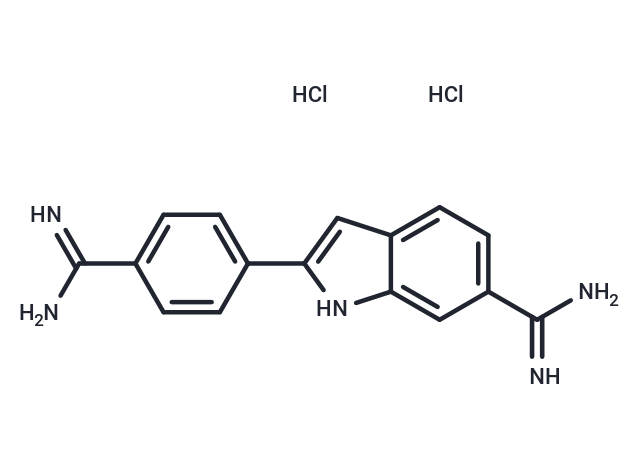Shopping Cart
- Remove All
 Your shopping cart is currently empty
Your shopping cart is currently empty

DAPI Dihydrochloride (FxCycle Violet) is a cell-permeable fluorescent probe by binding in the minor grove of A-T rich sequences of DNA, used to stain DNA and chromosomes, with a preference for adenine and thymine rich DNA.

| Pack Size | Price | Availability | Quantity |
|---|---|---|---|
| 5 mg | $35 | In Stock | |
| 10 mg | $62 | In Stock | |
| 25 mg | $133 | In Stock | |
| 50 mg | $213 | In Stock | |
| 100 mg | $318 | In Stock | |
| 200 mg | $473 | In Stock | |
| 1 mL x 10 mM (in DMSO) | $39 | In Stock |
| Description | DAPI Dihydrochloride (FxCycle Violet) is a cell-permeable fluorescent probe by binding in the minor grove of A-T rich sequences of DNA, used to stain DNA and chromosomes, with a preference for adenine and thymine rich DNA. |
| In vitro | DAPI dihydrochloride staining (adherent cells)
I. Preparation of working solution: Dissolve 1 mg DAPI dihydrochloride in 1 mL ddH2O/DMSO to obtain a 1 mg/mL stock solution. Use for adherent cells: For example, HeLa cells: Material preparation: PBS (phosphate buffered saline): used for cell washing and diluting DAPI dihydrochloride. Fixative solution: 4% paraformaldehyde (PFA) or glacial acetic acid fixative is commonly used. Sealants: For example, anti-fluorescence decay agents, help protect samples from light. Fluorescence microscope: used to observe staining results. II. Experimental steps 1. Cell fixation Culturing cells: Cultivate adherent cells on sterile coverslips (usually to 70-80% confluence). Fixed cells: 1) Aspirate the culture medium in the culture dish and wash the cells 1-2 times with PBS to remove the residual culture medium. 2) Add 4% PFA fixative and fix the cells at room temperature for 10-30 minutes (depending on the cell type). 3) After fixation, wash the cells 3 times with PBS buffer for 5 minutes each time to remove excess fixative. 2. DAPI staining Prepare DAPI working solution: DAPI is diluted in ddH2O/DMSO, usually at a concentration of 1-10 µg/mL. Staining: Add DAPI working solution (100 μL) to the fixed cells for 10-30 minutes, which can be adjusted according to the cell type and experimental requirements. 3. Washing Gently wash the cells 3 times with PBS buffer for 5 minutes each time to remove unbound DAPI dihydrochloride. 4. Sealing Prepare the sample: Add an appropriate amount of PBS or anti-fluorescence decay agent sealing solution and gently cover the coverslip. Fixation: Seal the edges of the coverslip with transparent tape or sealing agent to prevent drying. 5. Microscopic observation Use a fluorescence microscope to observe the staining results at a specific wavelength. The cell nucleus will show bright blue fluorescence. III. Precautions 1. Avoid light: DAPI dihydrochloride is light-sensitive and should be avoided from long-term exposure to light to prevent dye photodegradation. 2. Fixation time: The fixation time and conditions of different adherent cells may vary and need to be optimized according to the specific cell type. 3. Self-control: It is recommended to set up a negative control (unstained cells) to confirm the specificity and effectiveness of the staining. 4. Cell status: Ensure that the cells grow healthily before fixation to avoid dead cells affecting the staining results. 5. Please adjust the concentration of DAPI dihydrochloride working solution according to the actual situation. 6. This product is for scientific research only and is not for drug, home or other purposes. 7.For your safety and health, please wear a white coat and disposable gloves when operating. |
| Alias | FxCycle Violet, 4',6-diamidino-2-phenylindole |
| Molecular Weight | 350.24 |
| Formula | C16H17Cl2N5 |
| Cas No. | 28718-90-3 |
| Smiles | Cl.Cl.NC(=N)C1=CC=C(C=C1)C1=CC2=CC=C(C=C2N1)C(N)=N |
| Relative Density. | 1.41g/cm3 |
| Storage | keep away from direct sunlight,store at low temperature | Powder: -20°C for 3 years | In solvent: -80°C for 1 year | Shipping with blue ice. | ||||||||||||||||||||||||||||||||||||||||
| Solubility Information | H2O: 5 mg/mL (14.27 mM), Sonication is recommended. DMSO: 100 mg/mL (285.52 mM), Sonication is recommended. | ||||||||||||||||||||||||||||||||||||||||
Solution Preparation Table | |||||||||||||||||||||||||||||||||||||||||
H2O/DMSO
DMSO
| |||||||||||||||||||||||||||||||||||||||||

Copyright © 2015-2025 TargetMol Chemicals Inc. All Rights Reserved.